Chapter 8: Truth Tables Exercises (Symbolic Logic)
1/51
There's no tags or description
Looks like no tags are added yet.
Name | Mastery | Learn | Test | Matching | Spaced |
|---|
No study sessions yet.
52 Terms
truth table
a table that records every combination of truth values we can assign to the simple statements in an argument
used to test arguments
used to classify statements
used to classify pairs of statements
What are truth tables used for?
truth table definition for negation
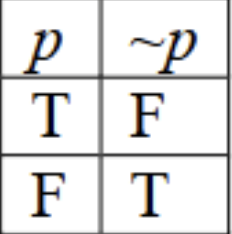
truth table definition for conjunction
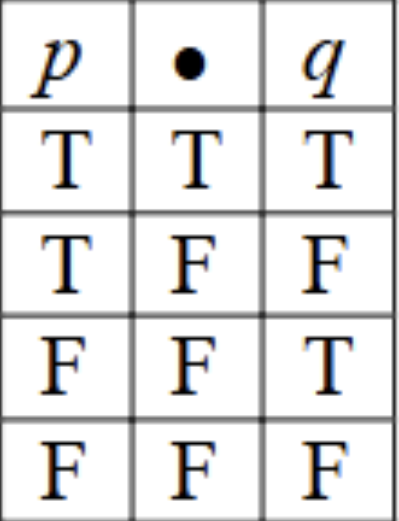
truth table definition for disjunction
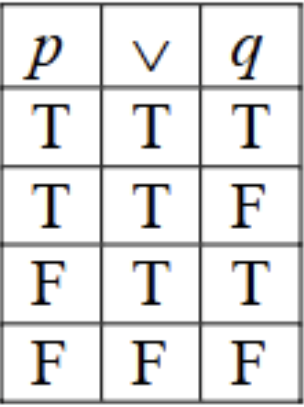
truth table definition for conditional
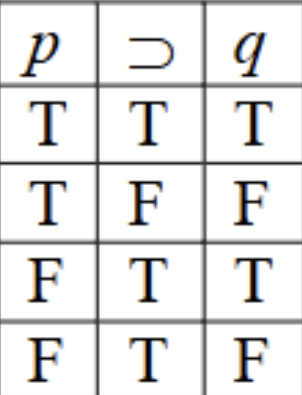
truth table definition for biconditional
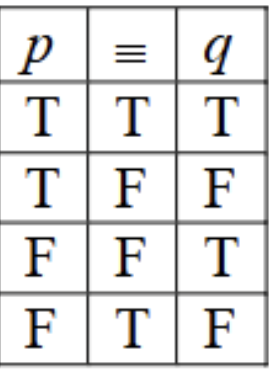
The truth value of the main operator of any compound statement is determined (can be computed) by the truth values assigned to the simple statements in it
What does it mean to say that the truth value of any compound statement is a function of the truth values assigned to its simple components?
true
disjunctive statements are true when at least one disjunct is true
Assume that A and B are true, that C and D are false, and that X and Z have unknown truth values.
Indicate whether the given statement is true, false, or has an undetermined truth value:
B ∨ Z
undetermined
can only determine true if both conjuncts are true
Assume that A and B are true, that C and D are false, and that X and Z have unknown truth values.
Indicate whether the given statement is true, false, or has an undetermined truth value:
A ● X
false
because true antecedent and false consequent
Assume that A and B are true, that C and D are false, and that X and Z have unknown truth values.
Indicate whether the given statement is true, false, or has an undetermined truth value:
A ⊃ (B ● C)
true
because at least one disjunct is true
Assume that A and B are true, that C and D are false, and that X and Z have unknown truth values.
Indicate whether the given statement is true, false, or has an undetermined truth value:
A ∨ [Z ⊃ (B ⊃ ∼C)]
false
idk why tbh
Assume that A and B are true, that C and D are false, and that X and Z have unknown truth values.
Indicate whether the given statement is true, false, or has an undetermined truth value:
B ≡ (D ∨ ∼A)
true
because consequent is true
Assume that A and B are true, that C and D are false, and that X and Z have unknown truth values.
Indicate whether the given statement is true, false, or has an undetermined truth value:
[X ∨ (∼A ≡ D)] ⊃ B
false
because the tilde negates the true statement
Assume that A and B are true, that C and D are false, and that X and Z have unknown truth values.
Indicate whether the given statement is true, false, or has an undetermined truth value:
∼[B ● ∼(C ∨ D)]
false
because there will be different truth values regardless
Assume that A and B are true, that C and D are false, and that X and Z have unknown truth values.
Indicate whether the given statement is true, false, or has an undetermined truth value:
Z ≡∼Z
true
because both conjuncts are true
Assume that A and B are true, that C and D are false, and that X and Z have unknown truth values.
Indicate whether the given statement is true, false, or has an undetermined truth value:
B ● (D ⊃ A)
true
if a statement is true, then every other statement implies it
Assume that A and B are true, that C and D are false, and that X and Z have unknown truth values.
Indicate whether the given statement is true, false, or has an undetermined truth value:
X ⊃ (A ⊃ X)
Count the number of different letters (let that = n)
Compute 2n = total number of lines in truth table
Divide total number of lines in half; start with the leftmost letter and fill in that many trues and falses alternating to the bottom everywhere this letter appears
Divide in half again; go to the leftmost letter and fill in this number of trues and falses alternating to the bottom everywhere this letter appears
Fill in the values for each operator.
Check to see whether, on any line, all the premises are true and the conclusion is false.
If yes, the argument is invalid.
If no, the argument is valid.
How is a truth table used to determine whether an argument is valid?
True
this makes it an EFFECTIVE method
True or False:
For any argument in propositional logic, the truth table method (unlike the method of counterexample) is guaranteed to produce a definite result (valid, invalid) in a finite number of mechanical steps if used correctly.
Valid
No matter what truth values are assigned to P and Q, the argument NEVER has TRUE premises and a FALSE conclusion.
AKA: there is no line that has 2 T premises and a F conclusion
Consult Pictures on Phone for Work
Test the argument below for validity using a truth table:
P ∨ Q
∼P
So, Q
Invalid
both premises are true and the conclusion is false
Consult Pictures on Phone for Work
Test the argument below for validity using a truth table:
P ⊃ Q
∼P
So, Q
Valid
no line w/ a true premise and a false conclusion
Consult Pictures on Phone for Work
Test the argument below for validity using a truth table:
P ∨ (Q ● P)
So, P
Invalid
both premises are true and the conclusion is false
Consult Pictures on Phone for Work
Test the argument below for validity using a truth table:
P ● Q
Q ⊃ R
So, ∼R
Valid
no line with a true premise and false conclusion
Consult Pictures on Phone for Work
Symbolize this argument and test it for validity using a truth table:
If Smith wins the election, then I’ll eat my hat. So, if I don’t eat my hat, then Smith didn’t win the election.
Valid
because no line with a true premise and false conclusion
Consult Pictures on Phone for Work
Symbolize this argument and test it for validity using a truth table:
This is gold if, and only if, its atomic number is 79. So, it’s being gold implies that its atomic number is 79, and its atomic number being 79 implies that it’s gold.
tautology
a statement that is necessarily true
could not possibly be false
Every line under the main operator is true
tautology in truth table terms
self-contradictory statement
a statement that is necessarily false
Every line under the main operator is false.
self-contradictory statement in truth table terms
contingent statement
a statement that is neither necessarily true nor necessarily false
There’s at least one line under the main operator on which the main operator is true andat least one on which its false.
truth table terms in contingent statement
tautology
because there’s a T under the main operator on every line.
Consult Pictures on Phone for Work
If a statement is true, everything implies it
Use a truth table to classify this statement:
X ⊃ (A ⊃ X)
Contingent
because at least one line where the main operator is true and at least one where it’s false.
Consult Pictures on Phone for Work
Use a truth table to classify this statement:
K ⊃ (K ≡ ∼L)
Self-Contradictory Statement
because every line under the main operator is false
Consult Pictures on Phone for Work
Use a truth table to classify this statement:
[∼B ● (B ∨ ∼A)] ● A
tautology
because every line under the main operator is true
When you negate a self-contradiction, the result must be a tautology.
Use a truth table to classify this statement:
∼(R ● ∼R)
The statements have the same truth value under the main operators on every line.
truth table terms of equivalent statements
The statements have the opposite truth value under the main operators on every line.
truth table terms of contradictory statements
There is at least one line where both statements have true main operators.
truth table terms of consistent statements
There is no line where both statements have true main operators.
truth table terms of inconsistent statements
a. = A)
b. = B)
c. = C)
d. = D)
Consult Pictures on Phone for Work
Use a truth table to put each pair of statements below into one of these categories:
A) Consistent, but not logically equivalent
B) Logically Equivalent
C) Inconsistent, but not contradictory
D) Contradictory
a. C ≡ D, and ∼D ⊃ C
b. ∼(R ● S), and ∼R ∨ ∼S
c. P ≡ Q, and P ● ∼Q
d. P ∨ Q, and ∼(Q ∨ P)
True
Mus be valid because the conclusion cannot be false if it’s a tautology. Since the conclusion cannot be false, then the argument can never have true premises and a false conclusion, and therefore the argument cannot be invalid.
True or False:
If an argument’s conclusion is a tauology, then the argument must be valid.
False
Two statements can both be true but not validly entail each other.
Ex:
There is a dog in this room.
There is a cat in this room.
True or False:
If two statements are logically consistent with one another, then each will validly entail the other.
Tautology
corresponding conditional of any statement is a tautology
Consult Picture on Phone for Work
Consider the valid argument below:
P ⊃ Q
P
So, Q
Now consider the statement:
[(P ⊃ Q) ● P] ⊃ Q]
If we were to construct a truth table to categorize this statement, what kind of statement would it be?
Invalid
No contradiction, so invalid
Test the argument below using an indirect truth table:
P ⊃ Q
Q
So, P
Valid
Because there’s a contradiction, the argument is invalid
There is a contradiction because if “∼Q” is false, then the dot can’t be true.
Test the argument below using an indirect truth table:
P ⊃ Q
∼Q ● ∼R
So, ∼P
Valid
Valid because there’s a contradiction
Impossible because the dotcan’t be true if P is false.
Test the argument below using an indirect truth table:
P ∨ (Q ● P)
So, P
equivalent
two statements that MUST have the SAME truth value
contradictory
two statements that MUST have OPPOSITE truth values
consistent
two statements that CAN be true simultaneously
inconsistent
two statements that CAN’T be true simultaneously
corresponding conditional
a conditional created by conjoining the premises of a valid argument and making them the antecedent AND making the conclusion of the argument the consequent